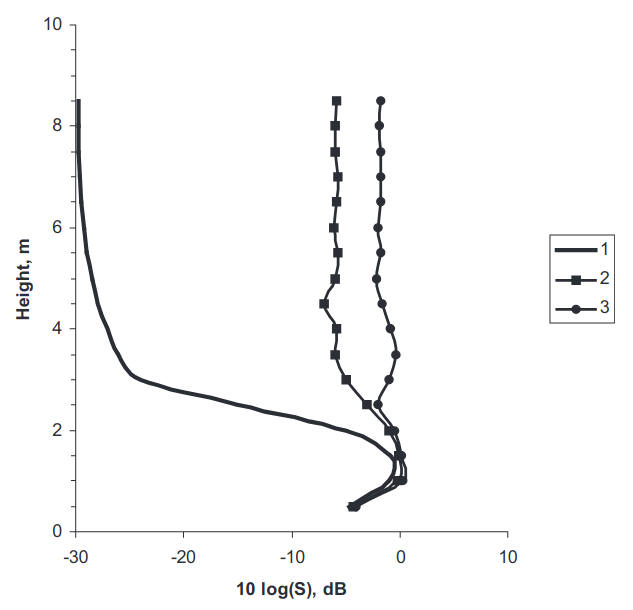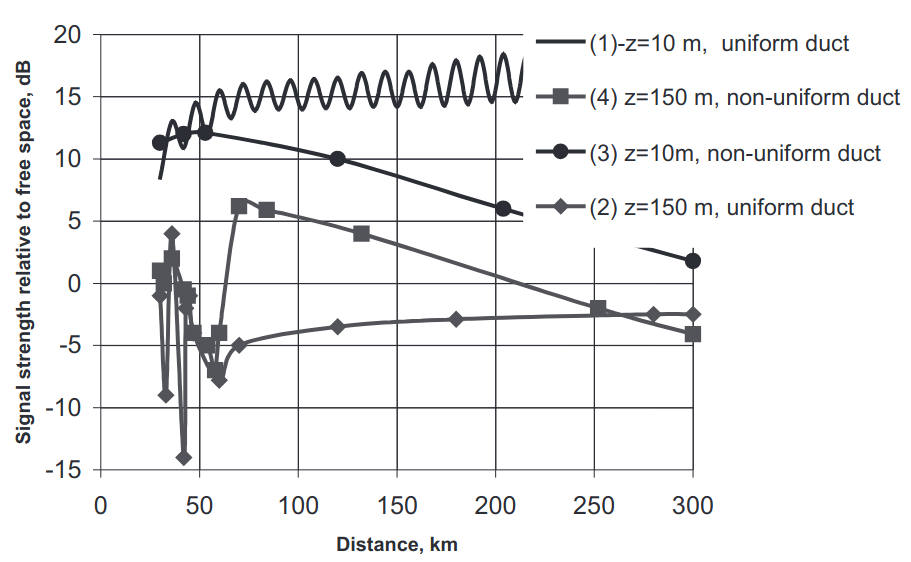Explore the phenomenon of wave excitation in evaporation ducts with a continuous spectrum, including the case of two trapped modes, and gain insights into the role of statistical inhomogeneity in shaping wave propagation patterns.
In the absence of fluctuations in refractive index, δε, the signal strength in the shadow region above the evaporation duct is exponentially small because of the smallness of the “sub-barrier leakage” of the trapped modes.
Excitation of Waves in a Continuous Spectrum in a Statistically Inhomogeneous Evaporation Duct
The contribution of the waves of the continuous spectrum, initially excited by the transmitter, can be neglected because of the diffraction attenuation in the shadow region. The scattering of the waveguide trapped modes by random non-uniformities of the refractive index gives rise to incoherent exchange of energy between trapped modes and excitation of waves in the continuous spectrum. In addition, the initially excited waves of the continuous spectrum may reach beyond the horizon due to a scattering in the upper layers of the troposphere (Booker–Gordon’s single scattering mechanism). In this section, we study the contribution of the waves of the continuous spectrum, whose source is a waveguide mode, to the intensity of the field, i. e. the mechanism of the excitation of waves of the continuous spectrum by trapped modes of the evaporation duct scattered on the imhomogeneities in the refractive index.
Recalling the equations for the coherence function from the previous section, we concentrate on investigation of the spectral amplitude of the component of the coherence function related to a continuous spectrum:
As is well known, in the presence of random fluctuations of the refractive index, δε, the coherent component of the waves of the continuous spectrum attenuates with distance due to incoherent multiple scattering. The decrement of attenuation in the coherent component is given by:
In the case of Kolmogorov’s turbulence:
Let us study the intensity of the field of the waves of the continuous spectrum:
setting the y-coordinates of the receiving and transmitting antennas to zero. Then, integrating Coherence Function in a Random and Non-uniform AtmosphereEquation and employing Coherence Function in a Random and Non-uniform Atmospherethe expression for the component of the coherence function associated with waves of the discrete spectrum, Γd, we obtain:
where we have introduced q = E1-E2, Q = (1/2)(E1+E2):
The integral B(q, Q) determines the coupling between the waves of the discrete and continuous spectra due to the scattering on the inhomogeneities of δε. The major contribution to B(q, Q) comes from the spectral components of δε with the wavenumbers:
with z < Zs and the region of the altitudes z1,2 in the neighbourhood of the turning point zd of the mode of the discrete spectrum, where U(zd) = Ed. We use the WKB approximation for the waves of the continuous spectrum and the Airy function representation for the waveguide mode in the vicinity of the turning point:
The spatial spectrum of the fluctuations in the refractive index we define in the form (Atmospheric Boundary Layer and Basics of the Propagation Mechanismsin this equation) for the case of turbulent fluctuations δε isotropic in the (x, y)-plane:
we substitute into Eqs. (4) and (5) the integral representation of the Airy function:
and require the inequalities:
to hold, which is necessary for the entire scheme of the solution obtained in Spectrum of Normal Waves in an Evaporation Duct“Detailed Wave Spectrum Analysis in Evaporation Ducts”. The meaning of inequality (7) is that we do not take into account the scattering of the leaky modes, assuming that the waveguide field is composed only of trapped (non-attenuated) modes. The B(q, Q) can then be truncated to:
where:
Parameter κd determines the Bragg scattering angle θs from the waveguide mode into the wave of the continuous spectrum with energy Q at the height of the turning point z = zd, i. e., 2 sin θs/2 = κd/k. The parameter Δk is a difference between the magnitude of the scattering angle at the surface z = 0 and at the altitude of the turn-ing point z = zd. Thus the inequality Δκ/κd ≪ 1 requires that the change in the scattering angle owing to refraction in the scattering volume, i. e. in the region of the mode’s localization, be much smaller than the scattering angle itself at the altitude zd.
The relationship between the characteristic “energy” Q and the sliding angle θ of the wave front of the wave of the continuous spectrum relative to the surface z = Zs is given by the equation Q = -k2/m2 tan2θ. The parameter Λd(Q) determines the distance along x traversed by the wave of the continuous spectrum with “energy” Q as it propagates from z = 0 to z = zd. Thus, B(q, Q) defines the angular distribution of the scattered field, i. e., the scattering function in the “directions” E1, E2.
where:
and:
We introduce the dimensionless variables τ = -Qm2/k2, τd = Edm2/k2, h = kz/m, β = m2γs/k and the modified profile U(h) = m2/k2U(z). We then require that the inequality:
holds. Since Λd(0) ≥ Λd(Ed), where kΛd(Ed) the length of the cycle of a waveguide mode and the contributing values of Q are limited by the inequality |Q| ≤ Ed, the condition (12) demands the smallness of the attenuation of the waveguide mode at the distance equal to its cycle. It may be noted that in the opposite case there is no waveguide mode structure to sustain scattering, the mode will be destroyed during one cycle.
Finally we obtain the intensity of the wave of the continuous spectrum normalized at the intensity of the free-space field:
We shall now study the total field in the shadow region as being the result of composition of the waves of the discrete and continuous spectra excited due to the random scattering of the waveguide modes. For the intensity of the waveguide mode the relation below follows:
We define the total intensity as:
where:
The function S(z) determines the height distribution of the total intensity of the field. We examine the behavior of the function S(z) in the case of a bilinear dependence of U(z). We assume the following values for the parameters of the problem:
- k = 2 cm–1;
- a = 8 500 km;
- Zs = 11 m;
- ΔεM = εM(0)-εM(Zs) = 5,8·106.
The modified profile U(h) can be defined as:
where:
- Hs = kZs/m = 2,42;
- U(0) = m2ΔεM = 4,34;
- τ1 = 2,338.
Consider the height dependence of the waveguide mode, i. e., the first term in S(z). Thus far in the analysis of the waveguide field we have neglected the leakage of the trapped waves of the discrete spectrum through the potential barrier. The attenuation caused by the effect of the leakage is accounted for in the imaginary part of Ed, which can be written as:
Sub-barrier leakage has virtually no effect on the height structure of the trapped mode inside the waveguide channel for h < Hs, where:
Outside the waveguide channel the height structure of ϕd(h) corresponds to an outgoing wave with amplitude proportional to the leakage factor δd:
Examining the second term in S(z) given by Eq. (18), we can express the coefficient in front of K(z) in terms of the non-dimensional attenuation coefficient b using Coherence Function in a Random and Non-uniform AtmosphereEquation for γd from the previous section:
Then for S(z) we obtain:
In principle, in order to determine the coefficient β it is necessary to know the magnitude of the structure constant Cε and the anisotropy parameter of the irregularities of the refractive index in the volume of the waveguide channel. In some cases when the radio signal strength is measured, the measured data may be deployed to estimate the height dependence of the received signal. In particular, when the magnitude of the field attenuation per unit length γx = dI/dx is known from the measured signal, then γd is related to γx via γx = 4,34γd, and given knowledge of the average M-profile we can construct a theoretical height structure of the field intensity S(z).
The γx magnitude for centimeter waves lies in the range γx = 0,2–0,5 dB km–1. The corresponding limits for β are β = 0,207–0,52 for k = 2 cm–1 and a = 8 500 km (normal refraction above the evaporation duct). Thus under real conditions the coefficient in front of K(z) in Coherence Function in a Random and Non-uniform AtmosphereEquation is of the order of unity and, consequently, the contribution of the waves of the continuous spectrum to S(z) can be significant.
Figure 1 shows the result of the calculation of the resulting height distribution 10 log S(h) based on Eq. (23) for β = 0,207 and β = 0,52 with U(h) given by Eq. (19) and its parameters defined above.

The figure also shows the height dependence of the first term in Eq. (23), i. e., the contribution of the waves of the discrete spectrum alone. As observed from the figure, the intensity of the field above the turning height hd (in this case hd = 1,67) is a contribution from the waves of the continuous spectrum, i. e. second term in Eq. (23). Apparently, scattering on random fluctuations in the refractive index leads to a significant change in the height dependence of the signal strength; in the presence of random fluctuations de in the refractive index there is no sharp exponential decay in the average signal strength outside the duct and for sufficiently strong fluctuations the δε field outside the duct may increase to the order of magnitude of the field inside, thus revealing a rather smooth unpronounced height dependence compared to the case of deterministic duct propagation.
At relatively large altitudes, h = Hs ≫ τd, the function S(h) has the following asymptotic form:
The exponential growth of those terms in Eq. (24) is due to the arrival of the waves from shorter distances x′ < x, at which the field of the waveguide mode was exponentially large, compared with its value at distance x. The second term makes the main contribution in Eq. (24), since the exponential factor β exceeds the sub-barrier leakage factor δ by at least an order of magnitude.
Evaporation Duct with Two Trapped Modes
Finally, we provide a closed form solution for the field intensity in the case when the evaporation duct can trap two modes. In this case the intensity in the two-mode waveguide is given by:
where:
Coefficients In0 = |χn(h0)|2 are the coefficients of the excitation of the mode with number n and function Sn(h) is a height distribution of the total intensity of the nth mode:
The height gain function χn is given by:
where δ is the coefficient of penetration through the potential barrier into the space above the duct:
The function Pn(h) is given by the integral:
where:
It should be noted that the above formulas actually represent the incoherent sum of two trapped modes. Under very moderate assumptions for the intensity of the atmospheric turbulent fluctuations (as in Figures 2 and 3 below) the interference term in the coherence function may be neglected since phase fluctuations in this case are strong enough to make the above approximation valid.

On Figure 2 the transmitter antenna is mounted at 10 m above the sea surface. Curves (1) and (2) correspond to the range dependence of the received field strength for the receiving antennas at the heights inside (1) and outside (2) the duct for the case of a uniform duct in the absence of random fluctuations in the refractive index. Curves (3) and (4) correspond to the same antenna elevations for a non-uniform duct with random and anisotropic fluctuations of the refractive index:

On Figure 3 The transmitter antenna is mounted at 10 m above the sea surface. Curve (1) shows the received field versus the height in the absence of random fluctuations in the refractive index. Curve (2) is a height-gain dependence for a non-uniform duct with random and anisotropic fluctuations of the refractive index:
To illustrate the effect of scattering on random fluctuations in a two-mode evaporation duct we calculated the signal strength at frequency 10 GHz in the evaporation duct with parameters Zs = 15 m and ΔM = 5 N-units. Figure 2 shows a range dependence of the signal strength in the absence and presence of the fluctuations in the refractive index. As observed from the figure, at a height 10 m inside the duct the composition of the two trapped modes produces an interference pattern, creating fades. The second curve shows the range dependence at the height 150 m where the second trapped mode is dominant and therefore no interference pattern is observed. The height gain pattern in this case is typical for one that follows from the model of the evaporation duct, namely, revealing the maximum of the signal strength inside the duct, Figure 3. In the presence of fluctuations we observe significant attenuation of the field with distance as well as considerable changes in the height gain distribution, namely, the height structure becomes largely uniform.
In the range of frequencies from 3 GHz to 20 GHz the evaporation duct in most cases can support only a few trapped modes. The calculation of the field strength for a finite number of modes can be performed in a way similar to that described in this section. The surface-based and elevated duct created by an advection mechanism and normally associated with strong elevated inversion of temperature may trap a hundred modes and the above approach is inefficient. In that case other methods based on the application of diffusion theory for a parabolic equation can be employed to solve the problem of scattering in a multimode waveguide.

